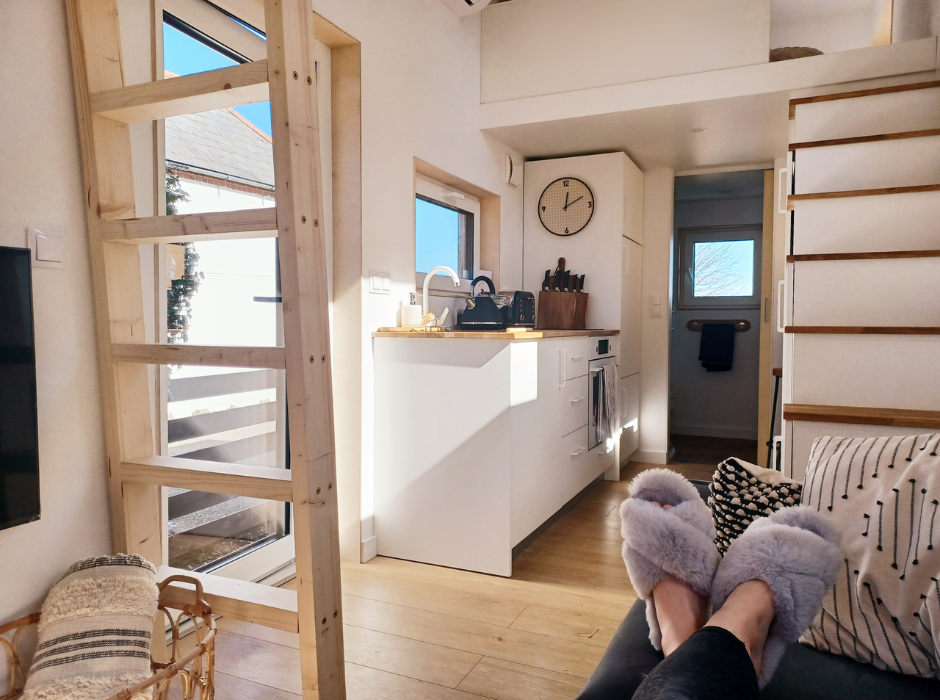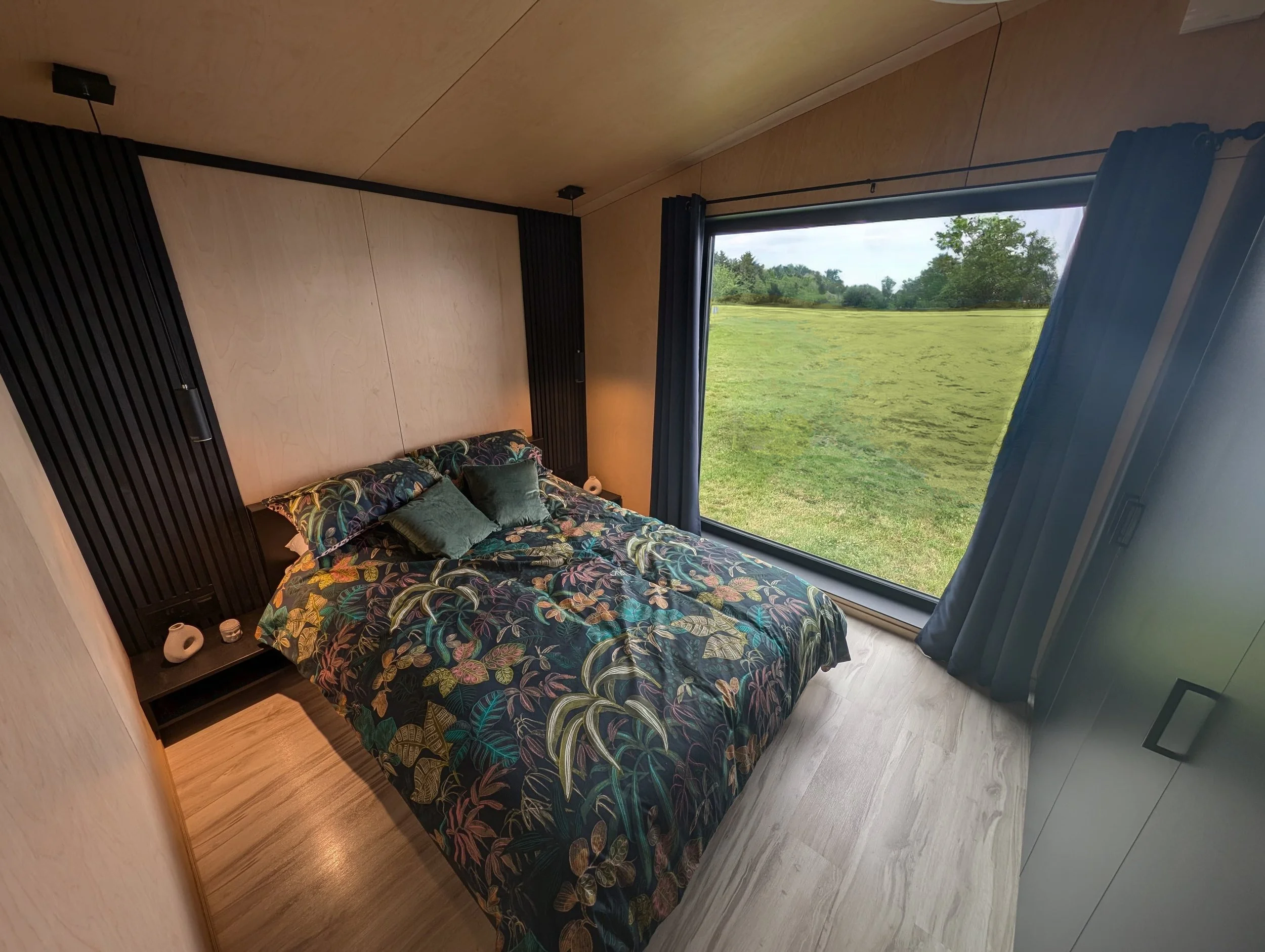Designing Healthier Tiny Homes: Why We Pair IKEA’s FRÖJERED Bamboo Kitchens with Cork, Fermacell & Micro‑CLT Interiors
By The Tiny Housing Co.
Downsizing shouldn’t mean downgrading your quality of life. In fact, building small gives us the freedom to be selective—to choose materials that tread lightly on the planet and actively support healthier indoor environments. That’s why, in several of our tiny home models, we lean on a smart mix of globally-available, rigorously-tested, and planet-forward products: IKEA’s FRÖJERED bamboo kitchen fronts, cork flooring from Amorim, Fermacell high‑performance fibre boards, and Micro‑CLT (small‑format cross‑laminated timber) interior elements. Together they create compact spaces that feel warm, durable, toxin‑aware, fire‑smart, and delightfully livable.
Why IKEA Components Work So Well in Tiny Homes
IKEA’s modular kitchen systems give us the flexibility to fit real cooking capability into compact footprints—critical when every millimetre counts. The FRÖJERED light bamboo fronts bring a warm, modern aesthetic while incorporating integrated handles that reduce visual clutter and minor projection—useful in tight galley passages. Just as important, FRÖJERED fronts are made from sustainably sourced bamboo over a lightweight core, helping us manage overall unit weight in mobile tiny homes (THOWs) and reducing material use without sacrificing strength.
A Material Choice with a Story
For FRÖJERED, IKEA deliberately chose bamboo because it’s a fast‑growing grass that doesn’t need irrigation or pesticides in the forests they source from, and because its structural properties make it hard‑wearing in the kitchen. The front’s lightweight recycled‑paper core helps conserve resources—“more with less.”
Climate & Resource Upside of Bamboo
Bamboo grows rapidly, regenerates without replanting in many cases, and binds CO₂ efficiently while producing oxygen—advantages that position it as a future‑ready renewable raw material when responsibly harvested.
Building a Health‑Forward Material Palette
Tiny homes concentrate everything—heat, moisture, cooking, living—into a small volume. Material choices matter disproportionately for indoor air quality, fire safety, acoustics, and day‑to‑day comfort. Here’s why we pair bamboo kitchens with cork underfoot, Fermacell for interior linings, and Micro‑CLT elements where we want to celebrate wood.
Cork Flooring from Amorim: Renewable, Carbon‑Smart Comfort
Cork is harvested by carefully removing the bark of the cork oak tree without felling it, allowing the tree to continue growing and regenerating new bark in cycles—an approach that supports long‑lived forests and biodiversity. Cork oak landscapes also act as powerful carbon sinks; studies associated with Amorim indicate that cork systems can help sequester significant amounts of CO₂ on a per‑ton production basis.
Because the tree stays in place and bark is removed on multi‑year cycles, responsibly managed cork can achieve carbon‑negative balances in certain flooring components, especially when compared with petrochemical foam alternatives. Life‑cycle analyses referenced by Amorim show negative cradle‑to‑gate carbon balances for some cork flooring sub‑assemblies.
Beyond climate metrics, cork offers real‑world liveability wins in small footprints: it’s naturally resilient and comfortable underfoot (great in kitchens where you stand), provides thermal and acoustic insulation, and can contribute to healthier indoor air quality when low‑emission products are specified (look for third‑party certifications such as GREENGUARD).
Fermacell: Fire‑Rated, Robust & VOC‑Active Interior Boards
Traditional gypsum plasterboard is familiar—but in tiny homes we often need materials that do more per millimetre. Fermacell gypsum fibre boards combine recycled gypsum with cellulose fibres from recycled paper and water to form dense, multi‑function panels that deliver fire resistance, impact strength, load‑holding capacity, moisture tolerance, and acoustic benefits in a single layer—reducing build‑ups in thin walls.
Fire Protection Where Space Is Tight
The Fermacell Firepanel A1 variant achieves European building material Class A1 non‑combustible status (EN 13501‑1) and is designed to provide structural fire protection in wall, shaft, and ceiling applications—an important safeguard around cooktops, heaters, and flue penetrations in compact dwellings.
Tested Performance & Single‑Layer Ratings
Fermacell systems have been tested to deliver up to 60 minutes fire resistance from single‑layer partitions (system‑dependent) while also managing moisture and impact demands—valuable when we’re trying to keep assemblies slim but safe.
Indoor Air Quality: Fermacell Greenline
For clients prioritising ultra‑low emissions, Fermacell Greenline boards incorporate an additive that actively absorbs and neutralises airborne volatile organic compounds (VOCs) (e.g., formaldehyde) to support healthier indoor air. Crucially, the Greenline version retains the mechanical, fire, and moisture properties of standard Fermacell boards.
Micro‑CLT & Exposed Wood: Bringing Biophilia into Small Spaces
Mass timber has surged in mainstream construction for good reason: cross‑laminated timber (CLT) stores carbon, is comparatively light, can offer predictable fire performance through surface charring, and allows precise, prefabricated assembly—all advantages that scale down beautifully for tiny homes.
Manufacturers have begun offering smaller‑format or “Micro‑CLT” elements suited to modular and compact builds; these panels make it easier to handle in confined workshops, reduce cut‑waste, and retain the sustainability and energy‑efficiency attributes of full‑scale CLT.
Beyond structure, exposed interior wood surfaces support a healthy indoor microclimate—wood buffers humidity swings, feels thermally warm to the touch, and contributes to biophilic cues shown in research to reduce stress and support mental well‑being. citeturn8view0turn8view1
Health & Well‑Being: The Biophilic Boost
A growing body of research links exposure to natural materials—especially wood—to measurable reductions in stress (lower cortisol, heart rate, blood pressure), improved mood, and higher occupant satisfaction. Biophilic design frameworks encourage the intentional use of natural textures, grain, and warm tones indoors to replicate some of nature’s restorative effects—something we can richly achieve even within 20–30m² when we choose the right finishes.
Putting It All Together in Our Tiny Home Models
Here’s how these materials come together in select Tiny Housing Co layouts:
1. The Galley Chef – A linear kitchen along one wall with FRÖJERED bamboo base cabinets and integrated handle fronts keeps circulation clear. Fermacell Firepanel backs the cooking zone behind the hob, while a continuous Amorim cork floor softens standing fatigue. Upper open shelving in Micro‑CLT keeps weight down and wood grain visible for biophilic warmth.
2. The L‑Shape Social – Wrap the corner with FRÖJERED fronts under a window; the natural bamboo tones bounce daylight, making the space feel larger. Fermacell Greenline lines adjacent living walls to actively reduce VOC load from furnishings, and cork underfoot improves acoustic comfort during gatherings. A Micro‑CLT feature wall doubles as a mounting surface for folding seating.
3. Off‑Grid Retreat – When weight and thermal performance are paramount, a hybrid envelope using Fermacell over structural timber, cork floating floor panels, and selectively exposed Micro‑CLT ceiling coffers delivers resilience, energy moderation, and a calming cabin vibe in a minimal footprint.
Saving While You Build Small
We’ve seen good deals recently on IKEA, and what we love about it, is that there are loads of options to do your own changes as you live in your tiny home. Check current IKEA offers via Capital One Shopping, for an example of this. Keep an eye out for other coupon / voucher websites as they promote IKEA well too.
Ready to Build a Tiny Home That’s Better for People and Planet?
If you’re curious about how these material strategies translate into healthier air, lighter footprints, and happier daily living in a compact space, get in touch with The Tiny Housing Co. We’ll help you tailor a material mix—bamboo, cork, Fermacell, Micro‑CLT, and more—to your lifestyle, budget, and climate zone.
Let’s design your healthy tiny home today.



